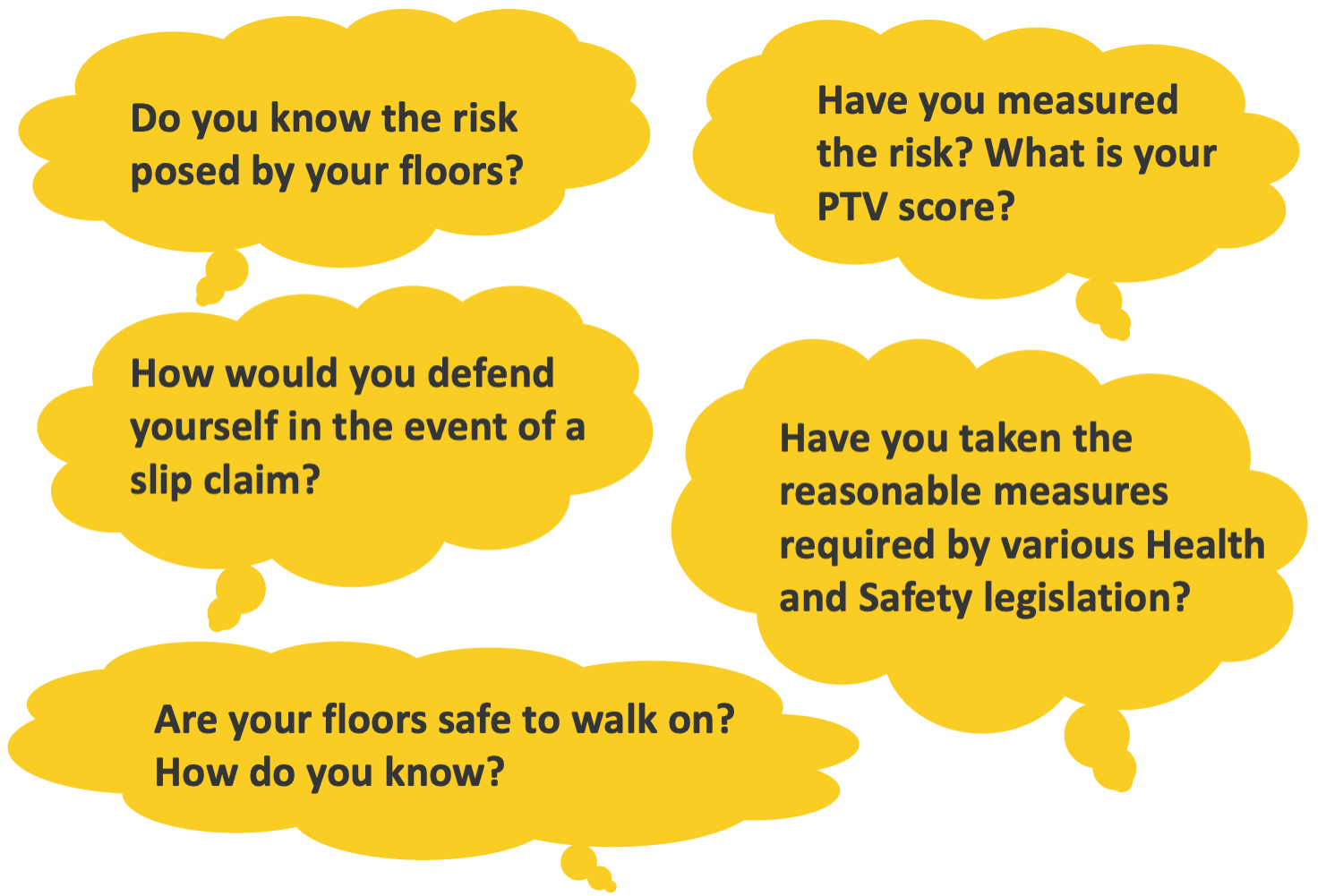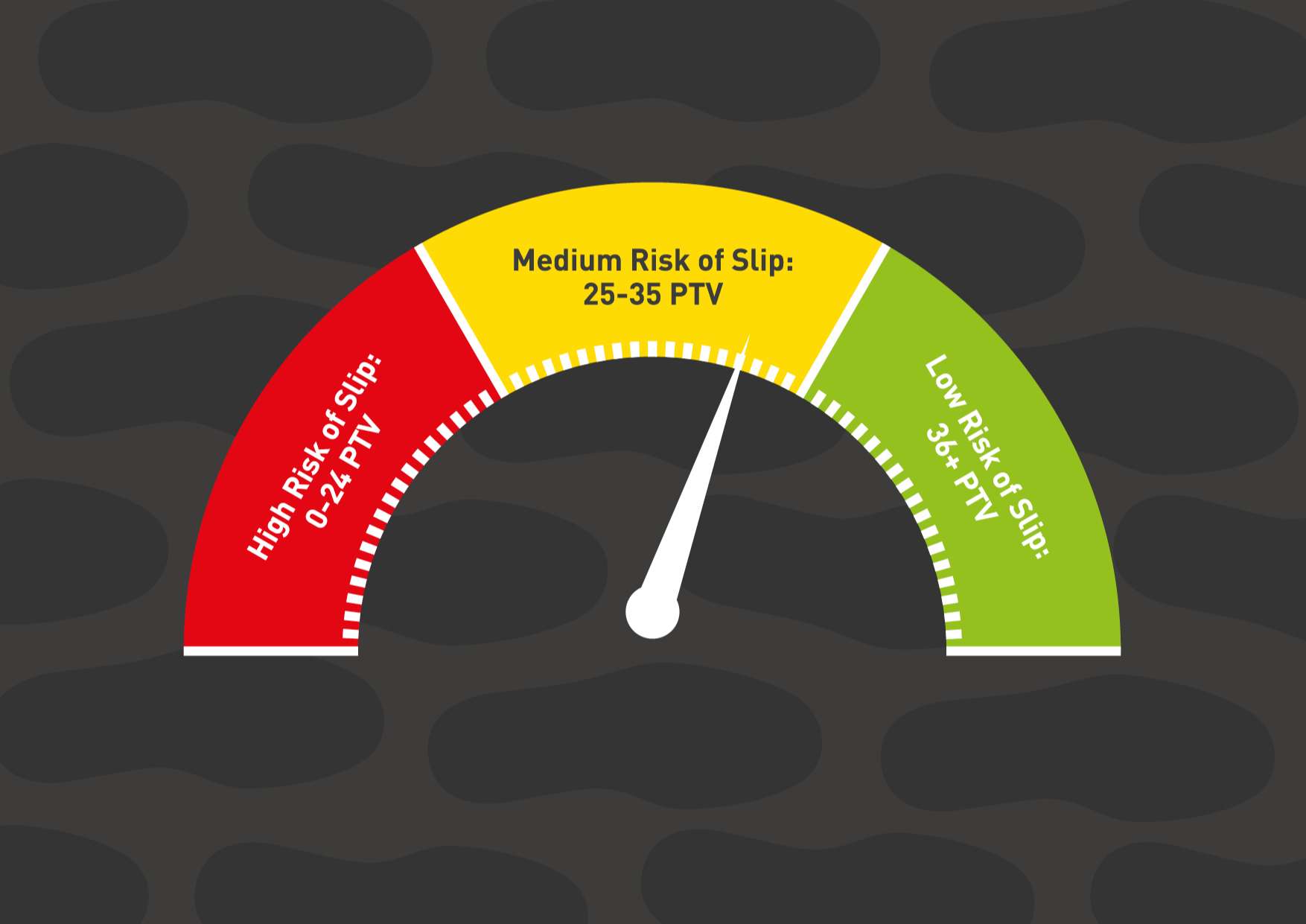Do you know the risk posed by your floors?
Slip Resistance Rating
When a floor is fitted you will often be given a slip resistance rating. Many flooring suppliers use the European R rating, but here in the UK we use a PTV (Pendulum Test Value) to determine how slippery a floor is.
Once in-situ however, there will be unique circumstances that will impact the floor’s performance, such as the environment, contamination, cleaning regimes, human behaviour and footwear and it is important to understand how these factors impact the slip risk to any pedestrians travelling across the floor.
So, we might start with what the manufacturer tells us, and should ensure this is a PTV score. If they do not have this information, it can be ascertained by undertaking independent testing carried out on a sample piece of the flooring using a Pendulum Tester, sometimes referred to as ‘lab testing’. Make sure you get this before you place the order for the flooring, as the PTV score categorises the floor performance by the level of slip risk, this is without any external influences. If it is fit for purpose, then proceed with the purchase and fitting of the flooring.
A floor’s performance changes in the Wet Vs Dry conditions and therefore both conditions are recorded in routine testing.
Once you know your scores and understand the environmental picture, you can start analysing and comparing patterns and results over time and in turn know how best to manage your floor to ensure you minimise slip risk for anyone walking on it!
Thus fulfilling your duty of care.
Let’s start with knowing your scores!

You should be able to answer these questions with confidence and the evidence to back it up – these answers enable you to demonstrate your duty of care is being fulfilled, demonstrate that you have taken reasonable measures to prevent slip and allow you to defend yourself if a slip, trip or fall occurs.
It is surprising how often people think that a quick walk over the floor surface and shuffling their feet to feel for the slipperiness under foot is enough. But all that tells you is that you, in your shoes, at that moment have not found the floor slippery. It doesn’t account for different footwear, different abilities, different contaminants, environmental factors and their impact on the slip risk and would certainly not stand up in court.
To really understand how slippery your floor surfaces are you should undertake a regular, independent slip testing regime, using 1 of the 2 testing methods recognised by the HSL/HSE. The Pendulum or the SlipAlert.
When we say ‘measure’ we mean really measure, you should have a number! A Pendulum Test Value (PTV) that tells you how slippery your floor surface is. This is a recognised measurement across the UK and will stand up in court.
The Pendulum Test Value ranges are split into 3 categories and displayed in a traffic light system, for ease of understanding:
0-24 indicate a high risk of slip
25-35 indicate a medium risk of slip
36+ indicates a high risk of slip
If we look at this in terms of probability of a slip:
- PTV of 20 indicates a 1 in 2 probability of a slip
- PTV of 24 indicates a 1 in 20 probability of a slip
- PTV of 27 indicates a 1 in 200 probability of a slip
- PTV of 36 indicates a 1 in 1 million probability of a slip

One of our favourite lines at SlipTest is ‘Ignorance is not a defence’ and you will no doubt hear us say this a lot. People often say ‘but if I find out my floor is slippery than I am causing an issue for myself and need to spend money to put it right, I’m better off not knowing’. But it doesn’t work that way and inactivity is not taking ‘reasonable measures.
In fact, if you do uncover an issue, the fact you have been pro-active goes in your favour and as long as you try to ensure that the floor surface is as safe as possible, through taking action to mitigate this risk (e.g. signage, changing cleaning regimes etc.) then you are showing action and fulfilling your duty of care.
We find that in 90% of cases the issue can be fixed by cleaning regimes alone. You just need to understand what is causing the results and how best to change the cleaning regime to combat the issue and that is where SlipTest can help.
You need evidence to demonstrate you have been pro-active and taken reasonable measures to manage your slip risk.
In our experience, if you have taken the ‘reasonable measures’ required of you by H&S legislation, then you should easily be able to defend a claim in court and would be able to provide the evidence to support your case and show appropriate duty of care has been taken.
Test your Floors:
- Know how your floor performs, know your PTV score.
- Undertake regular independent slip testing regimes, to monitor the performance over time.
- Build a picture of how your floor performs and compare and analyse results ongoing.
- Put into place actions if any increase of risk is identified.
- Repeat the process of measuring, analysing and acting where necessary.
Training and Education
- Train staff.
- Learn to recognise and reduce contamination.
- Adjust cleaning regimes accordingly for the changes in environment and contamination.
- Educate staff and encourage proactive behaviours.
- Thoroughly document incidents.
Slip Risk Awareness Training covers this and more.
This type of information and a picture that has been built up over time are the key elements that will help you defend a slip claim should you end up in court.
If you are unsure of the scores of the floors in your premises, get in touch today!
Did you know?
So far this year slips have cost society at least:
50%
of all accidents to the public are slips and trips.



